 |
||
|
||
| ||
 CONTENTS
Persistency of SIS in promotion of its new product and improvement of the chip production technology is not unnoticeable, and there are such companies as Joytech and Gigabyte which are dealing with the Xabre! Earlier we reviewed some Triplex products and, in particular, its card on this GPU. By the way, let me remind you of the articles on the Xabre based products that we have already published: Theoretical materials and reviews of video cards which concern functional
properties of the Currently the market offers only Xabre 400 cards operating at 250 MHz. The Xabre 200 (200 MHz) and Xabre 80 (200 MHz, SDR or 64-bit DDR memory) are still unsupported by manufacturers because the Xabre 400 with its price/speed ratio does not look attractively in its market niche, and the Xabre 200 must be priced as the GeForce2 MX, which will hardly please potential manufacturers. The Xabre 600 (275 MHz) will come soon as well but SIS hasn't yet announced mass production of such chips. However, the overclocking of the card in question shows that operation at such frequencies is possible. CardThe card has an |
| Joytech Apollo Blade Monster Xabre 400 128MB | |
|---|---|
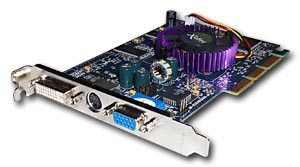 |
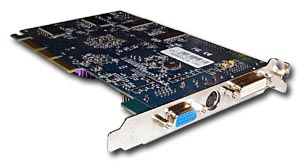 |
| Joytech Apollo Blade Monster Xabre 400 128MB | |
|---|---|
| The card comes with Samsung memory of 4ns access time which corresponds to 250 (500) MHz. The memory works at this frequency. The GPU runs at 250 MHz as well. | 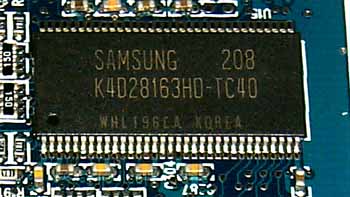 |
| Comparison with the reference design, front view | |
|---|---|
| Joytech Apollo Blade Monster Xabre 400 128MB | Reference card SIS Xabre 400 64MB |
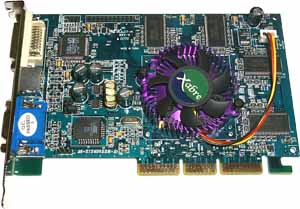 |
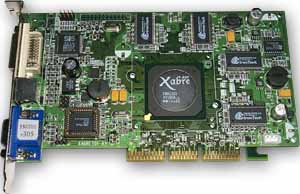 |
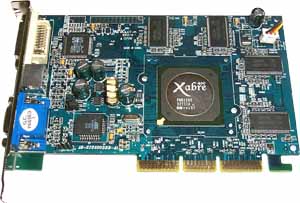 |
|
| Comparison with the reference design, back view | |
|---|---|
| Joytech Apollo Blade Monster Xabre 400 128MB | Reference card SIS Xabre 400 64MB |
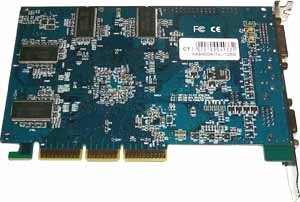 |
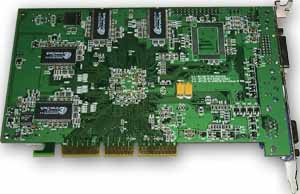 |
![]()
An experienced tester doesn't have to look at the marking of the memory chips: 8 DDR SDRAM chips of the old package housing 128 MB are typical only of Samsung (almost all cards with such memory size and the old design without a BGA package have memory from Samsung).
Although the design is based on the reference one, the guys from Joytech made their own card. Its PCB is shorter and the elemental base is a little different. But the main parts of the card, including the SIS 301 coprocessor, are in their due places:
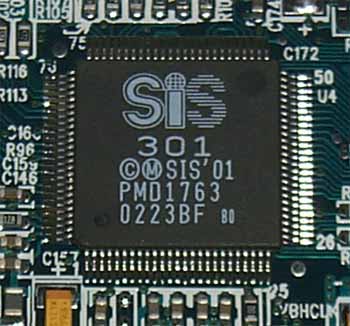
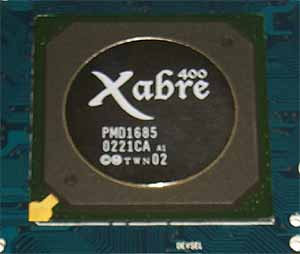
Now let's pop into the box and see what's inside.
| Joytech Apollo Blade Monster Xabre 400 128MB | |
|---|---|
| CD with drivers, CD with Sacrifice game, brief installation guide and S-Video extender. | 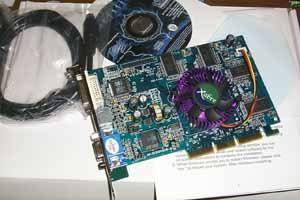 |
And the box...
| Joytech Apollo Blade Monster Xabre 400 128MB | |
|---|---|
| ... has a traditional bloody name written on it. This package is designed for the whole Xabre series (and the chip used is marked in a circle below). | 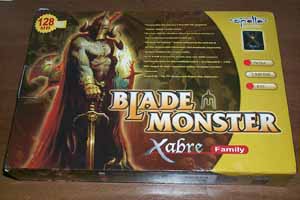 |
That's all we had to say about peculiarities of the card.
| Joytech Apollo Blade Monster Xabre 400 128MB | 250/500 |
|---|
![]()
The card managed to reach frequencies higher than the Xabre 600 must work at. But to be safe we reduced the clock speed to 275/550 MHz - thus, we tested the Xabre 600 as well :-)
Note:
In the tests we used SIS drivers 3.03. It's impossible to disable VSync forcedly, but all tests used today can do that on their own.
For comparison we used the following cards:
| Joytech Apollo Blade Monster Xabre 400 128MB DDR | 1280x1024x85Hz, 1024x768x100Hz (in 1600õ1200 it is not very good) |
|---|
![]()
For 3D performance estimation we used:
As you might remember, the Xabre's drivers support 3 Turbo Modes which can be changed only in the Registry:

![]()
By changing the variable highlighted on the screenshot one can modify operation of the accelerator. In our first review on the Xabre we noted that at the highest speed (TurboMode=3) the graphics quality worsens considerably, there are problems even with bilinear filtering.
But it was with the old driver version. This time we fulfilled the tests on the latest version - 3.03, that is why it's possible to track how the performance changes. At the same time we can estimate a performance drop when the TurboMode is disabled (TurboMode=0). We will also compare performance of 64MB and 128MB cards.
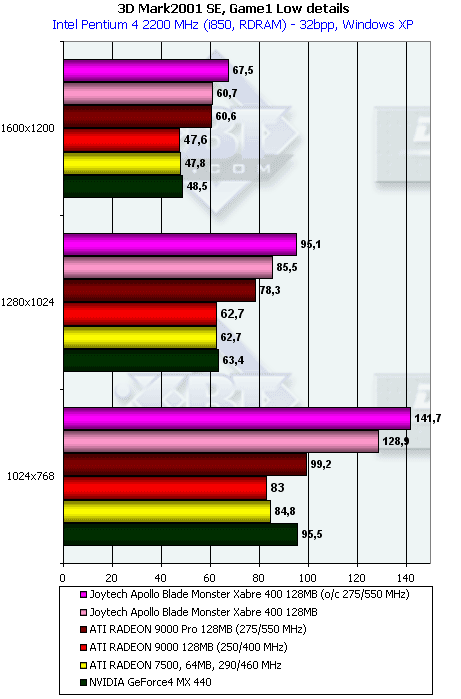
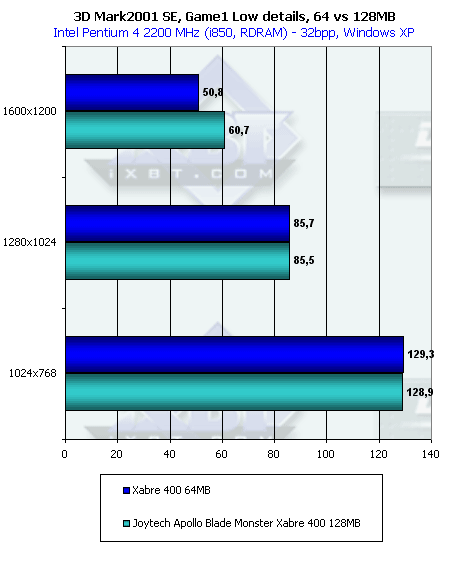
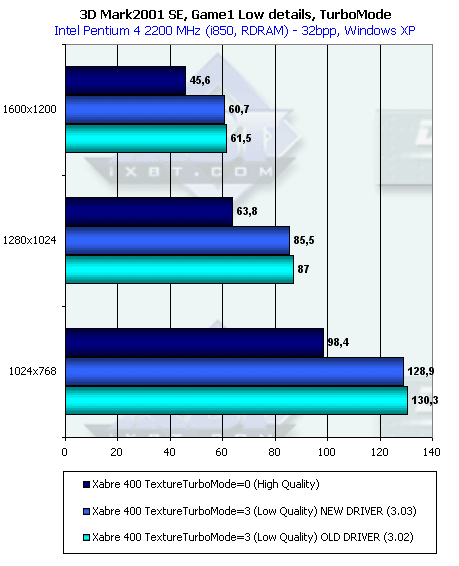
As for the drivers - the higher the version, the lower the speed, though the gap is insignificant. And when the TurboMode is disabled, the performance drops by a great margin.
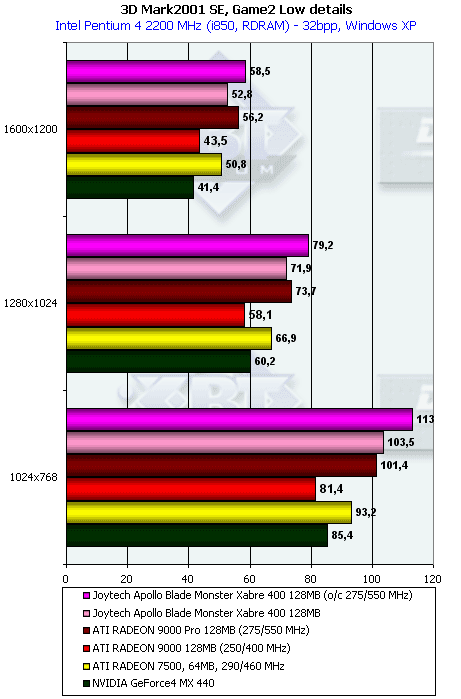
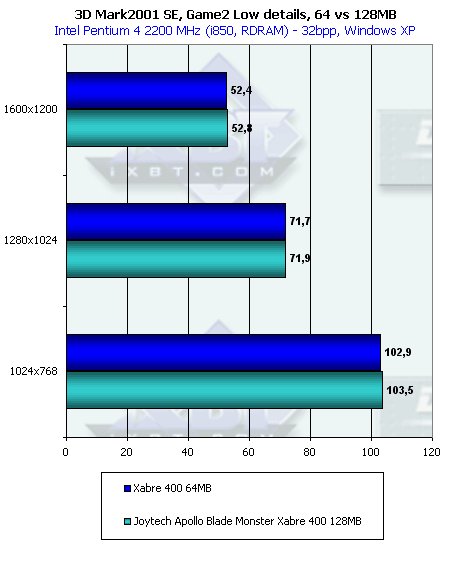
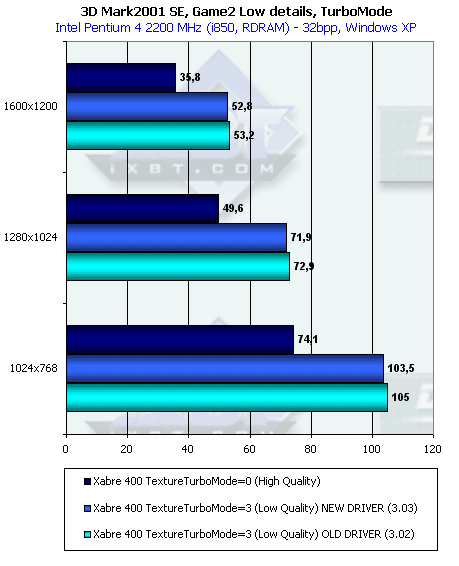
The questions regarding the TurboMode and comparison of the driver versions are the same as in the previous case.
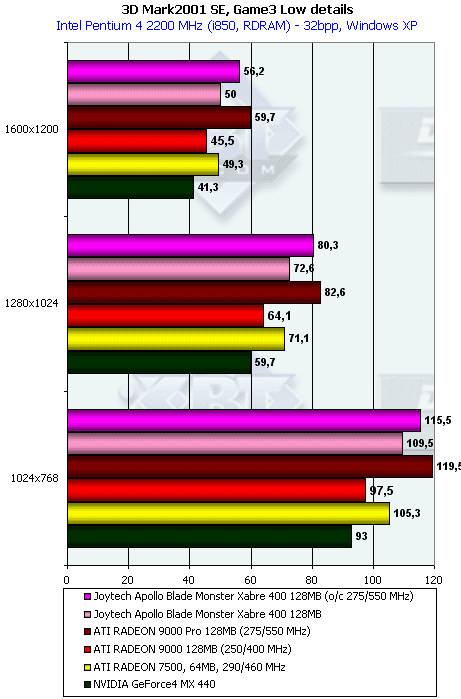
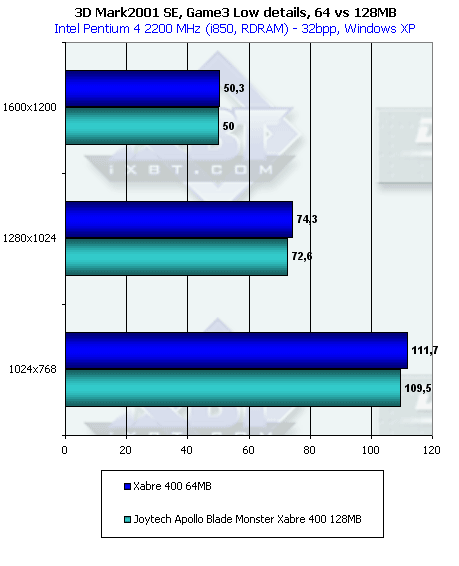
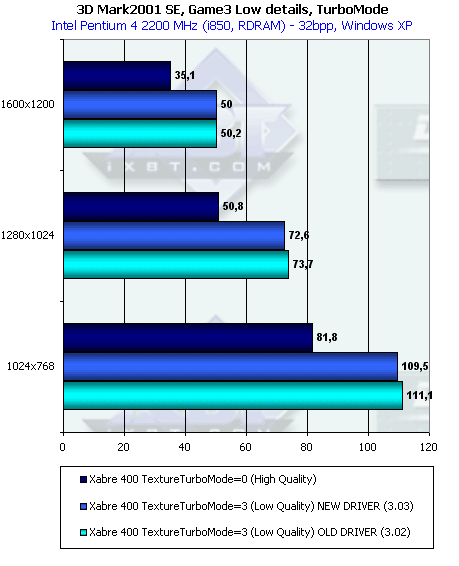
And we have nothing more to say about comparison of the driver version to what we mentioned above.
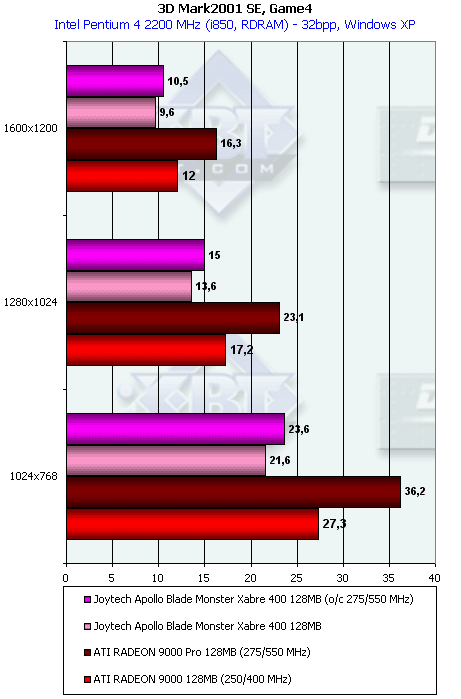
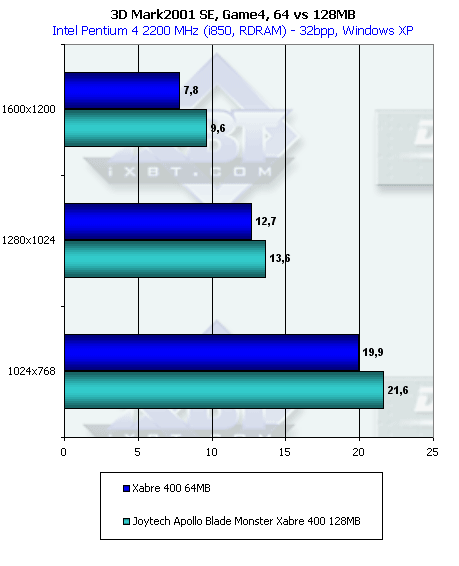
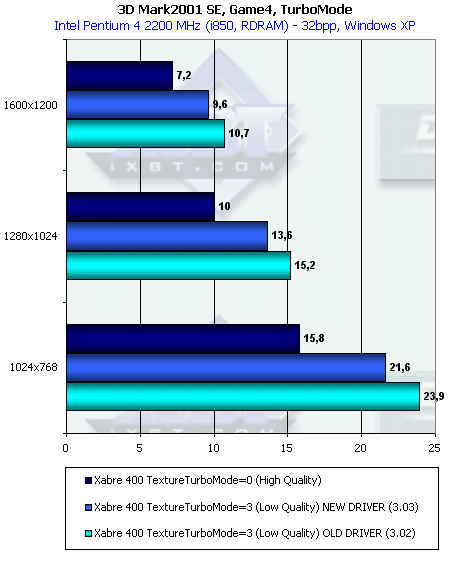
On the newer driver version the performance gets strongly worse. Why? It will soon become clear :-).
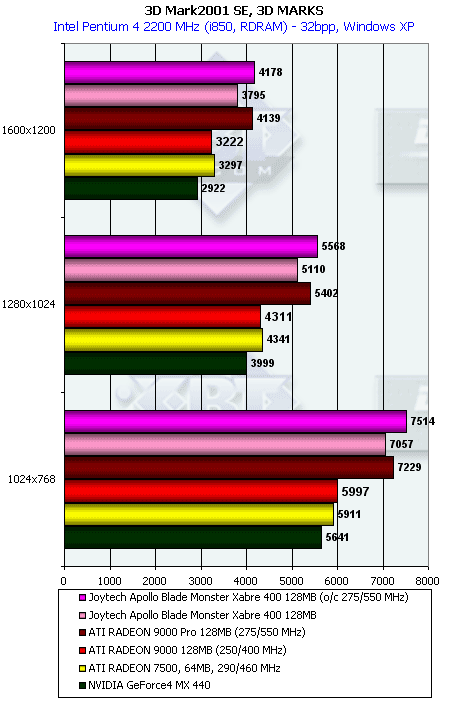

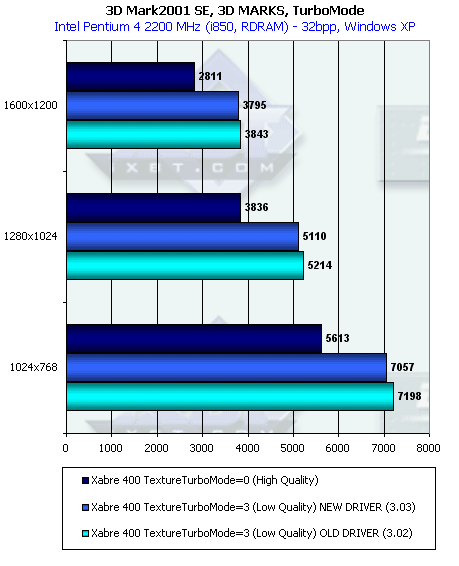
![]()
Well, the new version 3.03 provides a bit lower efficiency but much higher quality (the rumor has it that the improvement is achieved at the expense of LOD BIAS but I haven't found the exact proof)! Of course, the naturally good quality is not obtained but I hope soon it won't be necessary to switch to the TurboMode=0. Besides, the quality of processing of pixel shaders is higher again.
However, there are some problems: for example, the Morrowind game can't see shaders of the SIS Xabre. And there are some old quality flaws in certain games. Above all, lack of the trilinear filtering in TurboMode=3 is a real disadvantage.
Nevertheless, the progress is evident. We haven't considered yet operation of the Xabre in other tests but soon we will test one more video card based on this processor - stay tuned!
We are now witnessing how two processors are being destroyed: RADEON 7500 and GeForce4 MX 440. But while the former must leave the market as it is going to be replaced with the RADEON 9000, the latter won't give up easily. This will probably result in a severe price war because the cost price of the GeForce4 MX is quite low. And will the Xabre with its drawbacks in 3D graphics be able to stand against the RADEON 9000 which possesses anisotropy and trilinear filtering? Price will be a determining factor. If the prices are equal the Xabre will lose.
You can find more comparative characteristics of video cards of this and other classes in our 3Digest.
Highs:
Write a comment below. No registration needed!
|
Article navigation: |
| blog comments powered by Disqus |
| Most Popular Reviews | More RSS |
 |
Comparing old, cheap solutions from AMD with new, budget offerings from Intel.
February 1, 2013 · Processor Roundups |
 |
Inno3D GeForce GTX 670 iChill, Inno3D GeForce GTX 660 Ti Graphics Cards A couple of mid-range adapters with original cooling systems.
January 30, 2013 · Video cards: NVIDIA GPUs |
 |
Creative Sound Blaster X-Fi Surround 5.1 An external X-Fi solution in tests.
September 9, 2008 · Sound Cards |
 |
The first worthwhile Piledriver CPU.
September 11, 2012 · Processors: AMD |
 |
Consumed Power, Energy Consumption: Ivy Bridge vs. Sandy Bridge Trying out the new method.
September 18, 2012 · Processors: Intel |
| Latest Reviews | More RSS |
 |
Retested all graphics cards with the new drivers.
Oct 18, 2013 · 3Digests
|
 |
Added new benchmarks: BioShock Infinite and Metro: Last Light.
Sep 06, 2013 · 3Digests
|
 |
Added the test results of NVIDIA GeForce GTX 760 and AMD Radeon HD 7730.
Aug 05, 2013 · 3Digests
|
 |
Gainward GeForce GTX 650 Ti BOOST 2GB Golden Sample Graphics Card An excellent hybrid of GeForce GTX 650 Ti and GeForce GTX 660.
Jun 24, 2013 · Video cards: NVIDIA GPUs
|
 |
Added the test results of NVIDIA GeForce GTX 770/780.
Jun 03, 2013 · 3Digests
|
| Latest News | More RSS |
Platform · Video · Multimedia · Mobile · Other || About us & Privacy policy · Twitter · Facebook
Copyright © Byrds Research & Publishing, Ltd., 1997–2011. All rights reserved.